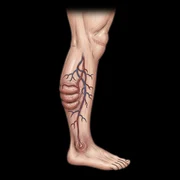Villalta Score Calculator for Post-thrombotic Syndrome
References:
- Assessment of validity and reproducibility of a clinical scale for the post‐thrombotic syndrome, by S Villalta, P Bagatella, A Piccioli, A Lensing, M. PRINS, P Prandoni, S Villalta, AW LENSING, MH Prins, AW Lensing, C Piccioli, AWA Lensing
- Kahn SR, Partsch H, Vedantham S, Prandoni P, Kearon C; Subcommittee on Control of Anticoagulation of the Scientific and Standardization Committee of the International Society on Thrombosis and Haemostasis. Definition of post-thrombotic syndrome of the leg for use in clinical investigations: a recommendation for standardization. J Thromb Haemost. 2009 May;7(5):879-83. doi: 10.1111/j.1538-7836.2009.03294.x. Epub 2009 Jan 19. PMID: 19175497.
Related Calculators:

More about the Villalta Score Calculator for Post-thrombotic Syndrome (PTS):
The Villalta Score is a clinically validated scoring system used to diagnose and grade the severity of Post-thrombotic Syndrome (PTS), a long-term complication of deep vein thrombosis (DVT). Characterized by chronic leg pain, swelling, skin changes, and in severe cases, ulceration, PTS affects a significant percentage of patients following DVT. Accurate and timely diagnosis is essential, and the Villalta Score provides a standardized framework for both clinical and research use.
Our calculator allows healthcare professionals to easily quantify the presence and severity of PTS based on patient-reported symptoms and physical findings. By offering a user-friendly and consistent tool, clinicians can track progression, evaluate treatment efficacy, and make better-informed management decisions.
Understanding the Villalta Score
The Villalta Score assesses five symptoms (pain, cramps, heaviness, paresthesia, pruritus) and six clinical signs (edema, skin induration, hyperpigmentation, redness, venous ectasia, and pain on calf compression). Each item is scored from 0 (absent) to 3 (severe). The total score reflects the overall severity of PTS:
- 0–4: No PTS
- 5–9: Mild PTS
- 10–14: Moderate PTS
- ≥15 or presence of ulcer: Severe PTS
This scoring system is recommended by the International Society on Thrombosis and Haemostasis (ISTH) and has been widely adopted in clinical trials and routine practice due to its ease of use and reproducibility.
Clinical Relevance
Post-thrombotic syndrome significantly impacts patient quality of life and is a major contributor to chronic venous insufficiency. Timely identification using the Villalta Score enables early interventions such as compression therapy, physical activity, pharmacologic management, and in some cases, endovascular procedures. Preventing the progression of PTS not only reduces morbidity but also alleviates the economic burden on healthcare systems.
PTS can develop weeks to months after a DVT event, and symptoms may persist for years if left untreated. Studies show that up to 50% of patients with proximal DVT may go on to develop some form of PTS. The Villalta Score helps identify those at risk early, offering a window of opportunity for preventative care and longitudinal monitoring.
Benefits of Using the Calculator
Our Villalta Score Calculator is optimized for both desktop and mobile use and streamlines the scoring process by:
- Reducing subjective variability in clinical assessments
- Providing real-time score interpretation and classification
- Allowing for consistent documentation across visits
- Facilitating shared decision-making with patients by offering a visual and quantitative explanation of their symptoms
Integration with Venous Thromboembolism (VTE) Care Pathways
Incorporating Villalta scoring into VTE management algorithms promotes comprehensive follow-up of DVT patients. It aligns with best practices from major vascular and hematology societies and supports research into novel therapeutic interventions for venous disease. Monitoring Villalta scores over time may help clinicians gauge response to interventions like graduated compression stockings (GCS), venous stenting, or catheter-directed thrombolysis.
Comparison with Other PTS Diagnostic Tools
While duplex ultrasound remains the gold standard for detecting residual thrombus or venous reflux, it does not measure clinical symptoms. The Villalta Score fills this gap by combining subjective and objective parameters to provide a holistic evaluation. When used alongside imaging, it enhances diagnostic confidence and facilitates more nuanced care planning.
Research Applications
The Villalta Score has been extensively validated in large-scale clinical studies such as the ATTRACT trial. It remains the cornerstone outcome measure in evaluating PTS development and therapeutic impact in longitudinal research. With growing interest in individualized thrombosis care, standardization via Villalta scoring supports reproducibility and cross-study comparison.
Limitations and Considerations
As with all clinical scoring systems, the Villalta Score has limitations, including inter-rater variability and reliance on subjective symptom reporting. However, its simplicity and high inter-observer agreement have supported its widespread adoption. Clinicians should be mindful of concurrent conditions (e.g., lymphedema, arthritis, neuropathy) that may mimic or confound PTS presentation.
Our calculator is designed for use by healthcare professionals and should not replace clinical judgment. In cases of uncertainty, correlation with imaging and vascular consultation is advised.
For additional resources, clinical guidelines, and references to key studies involving the Villalta Score, please refer to major vascular medicine literature or consensus statements from ISTH and the American Venous Forum.


